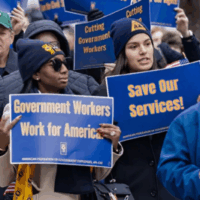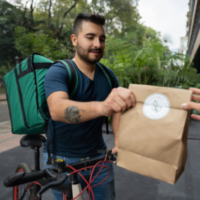
A Subway employee, a mother, and a grandmother in Brooklyn, Janice does everything at her restaurant: she makes food for customers, works the cash register, sweeps, mops, washes dishes, and cleans the bathroom. But even with all of these responsibilities, and despite the fact that she is a manager, she only makes minimum wage—which was $9 per hour until today.
Although she works 40 hours a week, Janice can still barely cover her basic essentials, including her rent, groceries, and phone bill.
“It’s really hard,” Janice says. “When I get my pay every week I have to make sure I put it in my account. My rent is $600, plus I have to buy a monthly MetroCard. I have to buy food and necessities. I usually make $320.60 a week when I work full time—after taxes. I have to struggle.”
Like many low-wage workers, Janice also has several family members depending on her for support. When she can, she sends what little money she has left over each month to her father and son in Jamaica, and she notes that her daughter and grandson are currently living in a shelter because she can’t afford housing that will accommodate them.
Janice’s margins are tight—especially when something goes wrong. Without meaningful benefits like paid sick leave, any unforeseen health issue is a major blow to her finances. Once, when she was sick and out of work for a week, she was forced to use her savings to support herself.
With such large financial barriers, it is difficult for Janice to plan for the future. But that doesn’t stop her from dreaming of a better life and good, stable jobs for herself, her family, and other workers.
“We have to get the union that can defend us when we’re sick, or our boss is targeting us, and that ensures we get enough hours, and our pay on time,” she says.
“I would like to find a place for my family to be together again. It’s not easy for me—but I would like to be able to visit my family in Jamaica too. It would mean so much to me. Also I would like to be able to help my daughter pay to further her education, which she would like to do.”
These goals may seem a little less distant as of today, December 31st, when Janice receives a much-needed boost to her income along with the millions of other workers in New York City and across the country who are receiving hard-won minimum wage increases this New Year’s weekend.
Earlier in 2016, New York became one of the first states to approve a $15 minimum wage. As a first step, low-wage workers in New York City receive pay raises on December 31st to $11—and to $12 for fast-food workers like Janice. (For very small businesses with fewer than 10 workers, the wage will be a little lower, $10.50.) In the suburbs, the minimum wage becomes $10, and upstate it goes to $9.70.
When these raises to $15 are fully phased in over the next several years, more than one in three workers in New York will receive long-overdue raises averaging $4,900 per year. For workers who’ve been struggling on just $18,000, that’s life-changing difference.
These historic increases in New York are part of a national wave of minimum wage victories in 2016—achieved in large part through the Fight for $15 campaign and the organizing power of the Service Employees International Union and other worker groups. Janice’s local union, 32BJ SEIU, provided extensive support for Fight for $15, which began when a few hundred fast-food workers walked off their jobs in 2012, demanding a $15 minimum wage and collective bargaining rights.
Throughout 2016, a total of 25 states and localities enacted minimum wage increases, including seven states and 18 cities and counties—raising pay for 11.8 million workers. Many of these wins confirmed the overwhelming public support for raising the minimum wage: on Election Day, voters approved ballot measures in Arizona, Colorado, and Maine to $12 per hour, and to $13.50 in Washington. In those states, the minimum wage increases received more votes than any of the candidates for president.
With the minimum wage increases in 2016, 19 million workers across the country have won $61.5 billion in raises since the Fight for $15 began in 2012.
Still, as exciting as these advances are, there is still a long way to go for workers like Janice, whose jobs still don’t give them what they need to provide a decent life for themselves and their families. Low-wage employers change their work schedules frequently, making it hard for them to earn a stable income, plan child care, and balance other responsibilities. Most low-wage jobs provide few benefits. And while their pay is now going up, so is the cost of living.
“It will make a difference when the wage goes up, but MetroCard fares are going up in March, and food keeps going up,” Janice says. “It will make it a little easier . . . but when you look at the next stage—everything is going up.”
Rather than letting that fact overwhelm her, Janice sees it as motivation to continue her fight.
“We have to let our bosses know that we are the ones that made that money for you,” she says. “Our lives are in jeopardy so we have to go out there. I would encourage all fast-food workers to go out there and demonstrate.
“We have to keep fighting to make these jobs better.”




